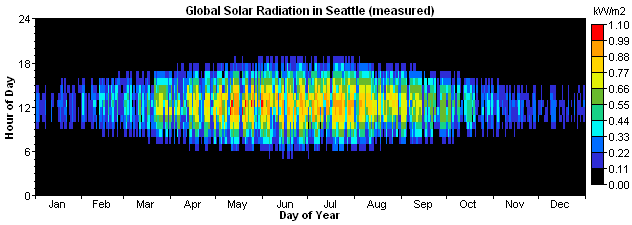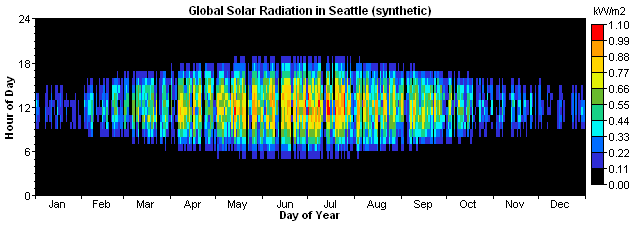
HOMER Grid 1.9

You can use HOMER to generate synthetic hourly solar data from monthly average data if you do not have measured solar radiation data. HOMER synthesizes hourly solar radiation data using an algorithm based on the work of V.A. Graham. This algorithm produces realistic hourly data, and is easy to use because it requires only the latitude and the twelve monthly average values.
The realistic nature of synthetic data created by this algorithm is shown in the two DMaps below. The first shows the measured TMY2 solar data for Seattle, WA. The second shows the synthetic data created by specifying Seattle's latitude and monthly average radiation values. The synthetic data display realistic day-to-day and hour-to-hour patterns. If one hour is cloudy, there is a relatively high likelihood that the next hour will also be cloudy. Similarly, one cloudy day is likely to be followed by another cloudy day.


The algorithm creates synthetic solar data with certain statistical properties that reflect global averages. So data generated for a particular location does not perfectly replicate the characteristics of the real solar resource. But our tests show that synthetic solar data produce virtually the same simulation results as real data. Differences in key performance output variables like annual PV array production, fuel consumption, generator run time, and storage throughput are typically less than 5%. Differences in key economic output variables like total net present cost and levelized cost of energy are typically less than 2%.
To generate synthetic solar data, go to the Solar Resource page. For each month, enter either the average clearness index or the average daily radiation. If you enter the clearness index, HOMER calculates the average daily radiation, and vice versa, using the latitude. For details, see the How HOMER calculates clearness index section of the help.
For assistance in finding monthly solar data, see Finding data to run HOMER.
See also
